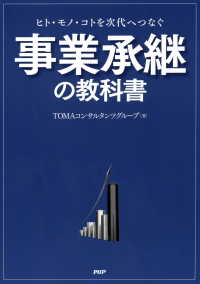- ホーム
- > 洋書
- > 英文書
- > Science / Mathematics
Full Description
This book – comprised of three separate volumes – presents the recent developments and research discoveries in structural and solid mechanics; it is dedicated to Professor Isaac Elishakoff. This second volume is devoted to the vibrations of solid and structural members.
Modern Trends in Structural and Solid Mechanics 2 has broad scope, covering topics such as: exact and approximate vibration solutions of rods, beams, membranes, plates and three-dimensional elasticity problems, Bolotin�s dynamic edge effect, the principles of plate theories in dynamics, nano- and microbeams, nonlinear dynamics of shear extensible beams, the vibration and aeroelastic stability behavior of cellular beams, the dynamic response of elastoplastic softening oscillators, the complex dynamics of hysteretic oscillators, bridging waves, and the three-dimensional propagation of waves.
This book is intended for graduate students and researchers in the field of theoretical and applied mechanics.
Contents
Preface xi
Noël CHALLAMEL, Julius KAPLUNOV and Izuru TAKEWAKI
Chapter 1. Bolotin's Dynamic Edge Effect Method Revisited (Review) 1
Igor V. ANDRIANOV and Lelya A. KHAJIYEVA
1.1. Introduction 1
1.2. Toy problem: natural beam oscillations 2
1.3. Linear problems solved 6
1.4. Generalization for the nonlinear case 8
1.5. DEEM and variational approaches 12
1.6. Quasi-separation of variables and normal modes of nonlinear oscillations of continuous systems 16
1.7. Short-wave (high-frequency) asymptotics. Possible generalizations of DEEM 17
1.8. Conclusion: DEEM, highly recommended 19
1.9. Acknowledgments 20
1.10. Appendix 20
1.11. References 21
Chapter 2. On the Principles to Derive Plate Theories 29
Marcus AßMUS and Holm ALTENBACH
2.1. Introduction 29
2.2. Some historical remarks 30
2.3. Possibilities to formulate plate theories 31
2.3.1. Theories based on hypotheses 32
2.3.2. Reduction of the governing equations by mathematical techniques 33
2.3.3. Direct approach 34
2.3.4. Consistent approach 36
2.4. Shear correction 36
2.5. Conclusion 38
2.6. References 39
Chapter 3. A Softening-Hardening Nanomechanics Theory for the Static and Dynamic Analyses of Nanorods and Nanobeams: Doublet Mechanics 43
Ufuk GUL and Metin AYDOGDU
3.1. Introduction 43
3.2. Doublet mechanics formulation 46
3.3. Governing equations 49
3.3.1. Static equilibrium equations of a nanorod with periodic micro- and nanostructures 49
3.3.2. Equations of motion of a nanorod with periodic micro- and nanostructures 51
3.3.3. Static equilibrium equations of a nanobeam with periodic micro- and nanostructures 53
3.3.4. Equations of motion of a nanobeam with periodic micro- and nanostructures 55
3.4. Analytical solutions 56
3.4.1. Axial deformation of nanorods with periodic nanostructures 56
3.4.2. Vibration analysis of nanorods with periodic nanostructures 57
3.4.3. Axial wave propagation in nanorods with periodic nanostructures 58
3.4.4. Flexural deformation of nanobeams with periodic nanostructures 59
3.4.5. Buckling analysis of nanobeams with periodic nanostructures 60
3.4.6. Vibration analysis of nanobeams with periodic nanostructures 60
3.4.7. Flexural wave propagation in nanobeams with periodic nanostructures 61
3.5. Numerical results 62
3.6. Conclusion 75
3.7. References 76
Chapter 4. Free Vibration of Micro-Beams and Frameworks Using the Dynamic Stiffness Method and Modified Couple Stress Theory 79
J.R. BANERJEE
4.1. Introduction 80
4.2. Formulation of the potential and kinetic energies 83
4.3. Derivation of the governing differential equations 86
4.4. Development of the dynamic stiffness matrix 88
4.4.1. Axial stiffnesses 89
4.4.2. Bending stiffnesses 90
4.4.3. Combination of axial and bending stiffnesses 92
4.4.4. Transformation matrix 93
4.5. Application of the Wittrick-Williams algorithm 94
4.6. Numerical results and discussion 95
4.7. Conclusion 104
4.8. Acknowledgments 104
4.9. References 104
Chapter 5. On the Geometric Nonlinearities in the Dynamics of a Planar Timoshenko Beam 109
Stefano LENCI and Giuseppe REGA
5.1. Introduction 109
5.2. The geometrically exact planar Timoshenko beam 114
5.3. The asymptotic solution 117
5.4. The importance of nonlinear terms 119
5.4.1. An initial case 119
5.4.2. The effect of the slenderness 126
5.4.3. The effect of the end spring 130
5.4.4. The effect of the resonance order 131
5.5. Simplified models 134
5.5.1. Neglecting axial inertia 135
5.5.2. One-field equation 136
5.5.3. The Euler-Bernoulli nonlinear beam 138
5.6. Conclusion 139
5.7. References 140
Chapter 6. Statics, Dynamics, Buckling and Aeroelastic Stability of Planar Cellular Beams 143
Angelo LUONGO
6.1. Introduction 143
6.2. Continuous models of planar cellular structures 145
6.2.1. Timoshenko beam 145
6.2.2. Shear beam 147
6.2.3. Elastic constant identification 148
6.3. The grid beam 149
6.3.1. Rigid transverse model 150
6.3.2. Flexible transverse model 151
6.3.3. Comparison among models 152
6.4. Buckling 154
6.4.1. Formulation 154
6.4.2. Critical loads 156
6.5. Dynamics 158
6.5.1. Timoshenko beam 158
6.5.2. Shear beam and discrete spring-mass model 159
6.6. Aeroelastic stability 160
6.6.1. Modeling a base-isolated tower 160
6.6.2. Critical wind velocity 162
6.7. References 163
Chapter 7. Collapse Limit of Structures under Impulsive Loading via Double Impulse Input Transformation 167
Izuru TAKEWAKI, Kotaro KOJIMA and Sae HOMMA
7.1. Introduction 167
7.2. Collapse limit corresponding to the critical timing of second impulse 171
7.3. Classification of collapse patterns in non-critical case 175
7.4. Analysis of collapse limit using energy balance law 177
7.4.1. Collapse Pattern 1' 177
7.4.2. Collapse Pattern 2' 178
7.4.3. Collapse Pattern 3' 179
7.4.4. Collapse Pattern 4' 179
7.5. Verification of proposed collapse limit via time-history response analysis 181
7.6. Conclusion 182
7.7. References 183
Chapter 8. Nonlinear Dynamics and Phenomena in Oscillators with Hysteresis 185
Fabrizio VESTRONI and Paolo CASINI
8.1. Introduction 186
8.2. Hysteresis model and SDOF response to harmonic excitation 187
8.3. 2DOF hysteretic systems 190
8.3.1. Equations of motion 191
8.3.2. Modal characteristics 192
8.4. Nonlinear modal interactions in 2DOF hysteretic systems 192
8.4.1. Top-hysteresis configuration (TC) 192
8.4.2. Base-hysteresis configuration (BC) 195
8.5. Conclusion 198
8.6. Acknowledgments 199
8.7. Appendix: Mechanical characteristics of SDOF and 2DOF systems 199
8.8. References 200
Chapter 9. Bridging Waves on a Membrane: An Approach to Preserving Wave Patterns 203
Peter WOOTTON and Julius KAPLUNOV
9.1. Introduction 203
9.2. Problem statement 205
9.3. Homogenized bridge 209
9.4. Internal reflections 213
9.5. Discrete bridge 217
9.6. Net bridge 222
9.7. Concluding remarks 226
9.8. Acknowledgments 227
9.9. References 227
Chapter 10. Dynamic Soil Stiffness of Foundations Supported by Layered Half-Space 231
Yang ZHOU and Wei-Chau XIE
10.1. Introduction 231
10.2. Generation of dynamic soil stiffness 233
10.2.1. Dynamic stiffness matrix under point loads 233
10.2.2. Formulation of the flexibility function 236
10.2.3. Formulation of Green's influence function 237
10.2.4. Total dynamic soil stiffness by the boundary element method 239
10.3. Numerical examples of the generation of dynamic soil stiffness 242
10.3.1. A rigid square foundation supported by a layer on half-space 243
10.3.2. A rigid circular foundation supported by a layer on half-space 244
10.3.3. A rigid circular foundation supported by half-space and a layer on half-space 244
10.4. Numerical examples of the generation of FRS 245
10.5. Conclusion 250
10.6. References 250
List of Authors 253
Index 255
Summaries of Volumes 1 and 3 257








